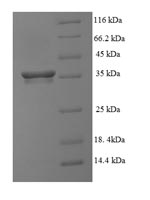Recombinant Human Vasculin (GPBP1) is produced in an E.coli expression system, covering amino acids 293-473 of the full protein. The protein carries an N-terminal 6xHis-SUMO tag to aid in purification and appears to enhance stability. SDS-PAGE analysis shows purity greater than 90%, which makes it appropriate for various research applications. This product is for research use only and is not intended for diagnostic or therapeutic purposes.
The GPBP1 gene encodes vasculin, which seems to play a role in transcriptional regulation and has been linked to modulating gene expression. It's involved in important pathways related to vascular development and function. Understanding this protein's activity and interactions may be essential for research focused on vascular biology and related fields, potentially offering insights into cellular processes and therapeutic targets.
Potential Applications
Note: The applications listed below are based on what we know about this protein's biological functions, published research, and experience from experts in the field. However, we haven't fully tested all of these applications ourselves yet. We'd recommend running some preliminary tests first to make sure they work for your specific research goals.
Human Vasculin is a eukaryotic protein that requires precise folding, potential post-translational modifications, and specific tertiary structure for its functional activity. The E. coli expression system cannot provide the eukaryotic folding environment, chaperones, or modifications needed for correct folding. The large N-terminal 6xHis-SUMO tag (∼15 kDa) is similar in size to the protein fragment itself (293-473aa, ∼20 kDa), which may cause significant steric interference with folding and functional domains. The partial fragment (293-473aa) lacks the full-length context, and the probability of correct folding with bioactivity is low without experimental validation.
1. Protein-Protein Interaction Studies Using Pull-Down Assays
This application carries a high risk without proper folding validation. GPBP1 interactions require native conformation. If correctly folded (verified), the protein may identify physiological partners. If misfolded/unverified, there is a high risk of non-specific binding or tag-mediated artefacts due to the large SUMO tag.
2. Antibody Development and Epitope Mapping
This application is highly suitable for generating antibodies against linear epitopes within the 293-473aa region. Antibody development relies on antigenic sequence recognition rather than functional folding. However, antibodies may not recognize conformational epitopes of the native, full-length protein.
3. Structural and Biophysical Characterization Studies
These studies are essential for determining folding status. Techniques like circular dichroism spectroscopy and dynamic light scattering can assess secondary structure and oligomerization. However, the SUMO tag may interfere with high-resolution structural studies, and removal may be necessary for meaningful analysis.
4. In Vitro Functional Assays and Biochemical Analysis
This application carries a significant risk without functional validation. GPBP1's biochemical activities require native folding. If correctly folded and active (verified), limited studies may be possible. If misfolded/inactive (unverified), assays will yield biologically misleading results.
Final Recommendation & Action Plan
The E. coli-expressed GPBP1 fragment with a large SUMO tag may not be properly folded for functional applications due to the lack of eukaryotic folding machinery and potential steric interference. Begin with Application 3 (Structural and Biophysical Characterization) to assess folding quality through techniques like CD spectroscopy and SEC. Applications 1 and 4 require rigorous folding and functional validation before proceeding. Application 2 (antibody development) can proceed immediately. For reliable GPBP1 research, use a full-length protein expressed in mammalian systems that supports proper folding and post-translational modifications.






